Centralization vs Decentralization of Supply Chain/Logistics
VerifiedAdded on 2022/11/14
|58
|15363
|377
Thesis and Dissertation
AI Summary
This dissertation investigates the critical decision of whether to centralize or decentralize the logistics function within a multinational corporation (MNC) based in the UAE. The research, conducted for XYZ, a global technology and engineering leader, addresses the current decentralized structure of its automation solutions platform, which consists of five business units with multiple logistics touchpoints. The study explores the challenges of the existing system, including inefficiencies, lack of cost optimization, and missed opportunities for savings. The research employs a literature review, examining supply chain processes, the dynamics and risks of logistics functions, and the concepts of centralization and decentralization. The methodology includes qualitative data collection, and the findings are discussed in relation to the literature. The dissertation aims to provide recommendations for XYZ's top management, aiding in their decision-making process regarding the optimal organizational structure for its logistics function to enhance cost control, improve speed and resilience, and ensure trade compliance. The structure of the dissertation follows a standard format, including introduction, literature review, methodology, results, discussion, and conclusions and recommendations.
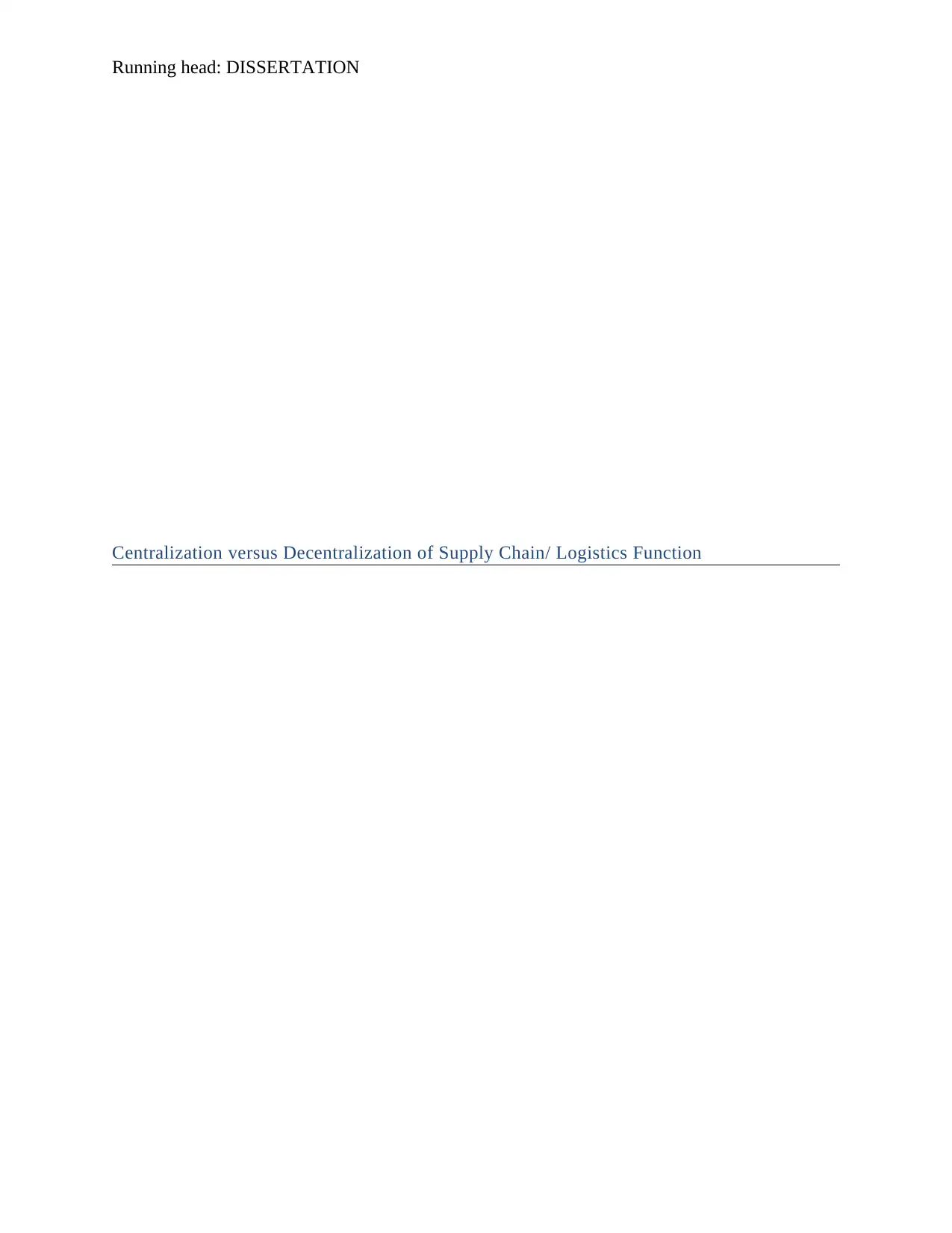
Running head: DISSERTATION
Centralization versus Decentralization of Supply Chain/ Logistics Function
Centralization versus Decentralization of Supply Chain/ Logistics Function
Paraphrase This Document
Need a fresh take? Get an instant paraphrase of this document with our AI Paraphraser
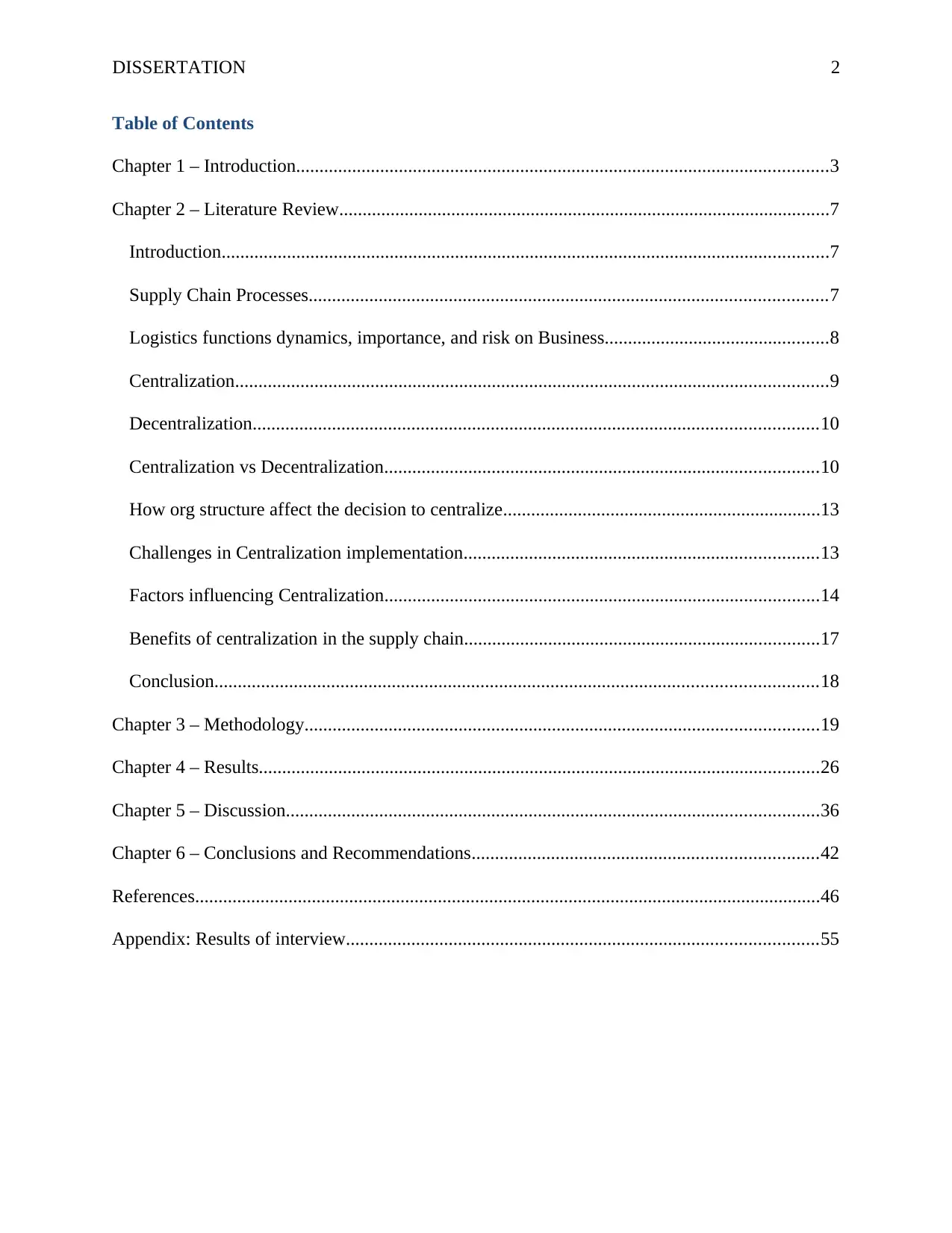
DISSERTATION 2
Table of Contents
Chapter 1 – Introduction..................................................................................................................3
Chapter 2 – Literature Review.........................................................................................................7
Introduction..................................................................................................................................7
Supply Chain Processes...............................................................................................................7
Logistics functions dynamics, importance, and risk on Business................................................8
Centralization...............................................................................................................................9
Decentralization.........................................................................................................................10
Centralization vs Decentralization.............................................................................................10
How org structure affect the decision to centralize....................................................................13
Challenges in Centralization implementation............................................................................13
Factors influencing Centralization.............................................................................................14
Benefits of centralization in the supply chain............................................................................17
Conclusion.................................................................................................................................18
Chapter 3 – Methodology..............................................................................................................19
Chapter 4 – Results........................................................................................................................26
Chapter 5 – Discussion..................................................................................................................36
Chapter 6 – Conclusions and Recommendations..........................................................................42
References......................................................................................................................................46
Appendix: Results of interview.....................................................................................................55
Table of Contents
Chapter 1 – Introduction..................................................................................................................3
Chapter 2 – Literature Review.........................................................................................................7
Introduction..................................................................................................................................7
Supply Chain Processes...............................................................................................................7
Logistics functions dynamics, importance, and risk on Business................................................8
Centralization...............................................................................................................................9
Decentralization.........................................................................................................................10
Centralization vs Decentralization.............................................................................................10
How org structure affect the decision to centralize....................................................................13
Challenges in Centralization implementation............................................................................13
Factors influencing Centralization.............................................................................................14
Benefits of centralization in the supply chain............................................................................17
Conclusion.................................................................................................................................18
Chapter 3 – Methodology..............................................................................................................19
Chapter 4 – Results........................................................................................................................26
Chapter 5 – Discussion..................................................................................................................36
Chapter 6 – Conclusions and Recommendations..........................................................................42
References......................................................................................................................................46
Appendix: Results of interview.....................................................................................................55
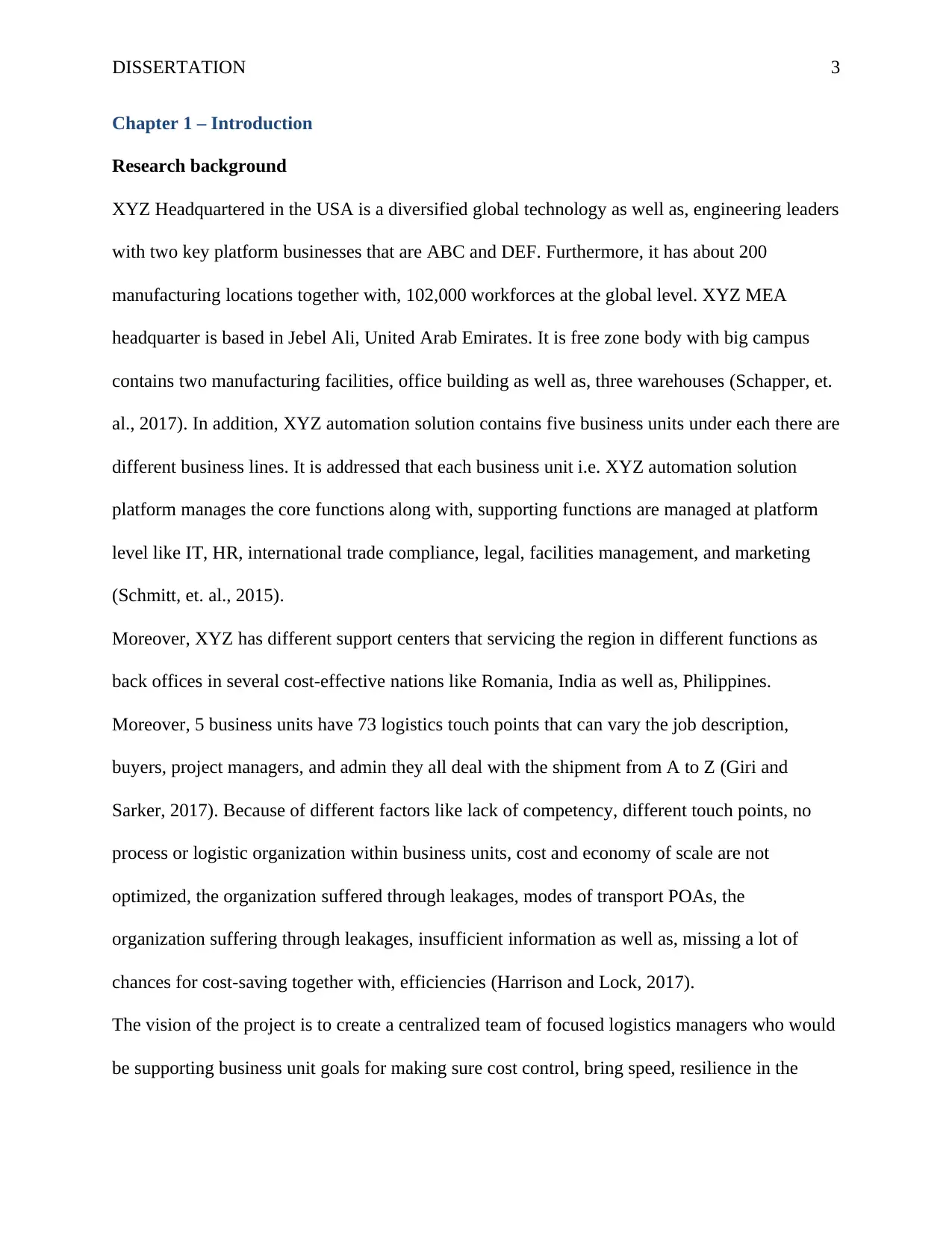
DISSERTATION 3
Chapter 1 – Introduction
Research background
XYZ Headquartered in the USA is a diversified global technology as well as, engineering leaders
with two key platform businesses that are ABC and DEF. Furthermore, it has about 200
manufacturing locations together with, 102,000 workforces at the global level. XYZ MEA
headquarter is based in Jebel Ali, United Arab Emirates. It is free zone body with big campus
contains two manufacturing facilities, office building as well as, three warehouses (Schapper, et.
al., 2017). In addition, XYZ automation solution contains five business units under each there are
different business lines. It is addressed that each business unit i.e. XYZ automation solution
platform manages the core functions along with, supporting functions are managed at platform
level like IT, HR, international trade compliance, legal, facilities management, and marketing
(Schmitt, et. al., 2015).
Moreover, XYZ has different support centers that servicing the region in different functions as
back offices in several cost-effective nations like Romania, India as well as, Philippines.
Moreover, 5 business units have 73 logistics touch points that can vary the job description,
buyers, project managers, and admin they all deal with the shipment from A to Z (Giri and
Sarker, 2017). Because of different factors like lack of competency, different touch points, no
process or logistic organization within business units, cost and economy of scale are not
optimized, the organization suffered through leakages, modes of transport POAs, the
organization suffering through leakages, insufficient information as well as, missing a lot of
chances for cost-saving together with, efficiencies (Harrison and Lock, 2017).
The vision of the project is to create a centralized team of focused logistics managers who would
be supporting business unit goals for making sure cost control, bring speed, resilience in the
Chapter 1 – Introduction
Research background
XYZ Headquartered in the USA is a diversified global technology as well as, engineering leaders
with two key platform businesses that are ABC and DEF. Furthermore, it has about 200
manufacturing locations together with, 102,000 workforces at the global level. XYZ MEA
headquarter is based in Jebel Ali, United Arab Emirates. It is free zone body with big campus
contains two manufacturing facilities, office building as well as, three warehouses (Schapper, et.
al., 2017). In addition, XYZ automation solution contains five business units under each there are
different business lines. It is addressed that each business unit i.e. XYZ automation solution
platform manages the core functions along with, supporting functions are managed at platform
level like IT, HR, international trade compliance, legal, facilities management, and marketing
(Schmitt, et. al., 2015).
Moreover, XYZ has different support centers that servicing the region in different functions as
back offices in several cost-effective nations like Romania, India as well as, Philippines.
Moreover, 5 business units have 73 logistics touch points that can vary the job description,
buyers, project managers, and admin they all deal with the shipment from A to Z (Giri and
Sarker, 2017). Because of different factors like lack of competency, different touch points, no
process or logistic organization within business units, cost and economy of scale are not
optimized, the organization suffered through leakages, modes of transport POAs, the
organization suffering through leakages, insufficient information as well as, missing a lot of
chances for cost-saving together with, efficiencies (Harrison and Lock, 2017).
The vision of the project is to create a centralized team of focused logistics managers who would
be supporting business unit goals for making sure cost control, bring speed, resilience in the
⊘ This is a preview!⊘
Do you want full access?
Subscribe today to unlock all pages.

Trusted by 1+ million students worldwide
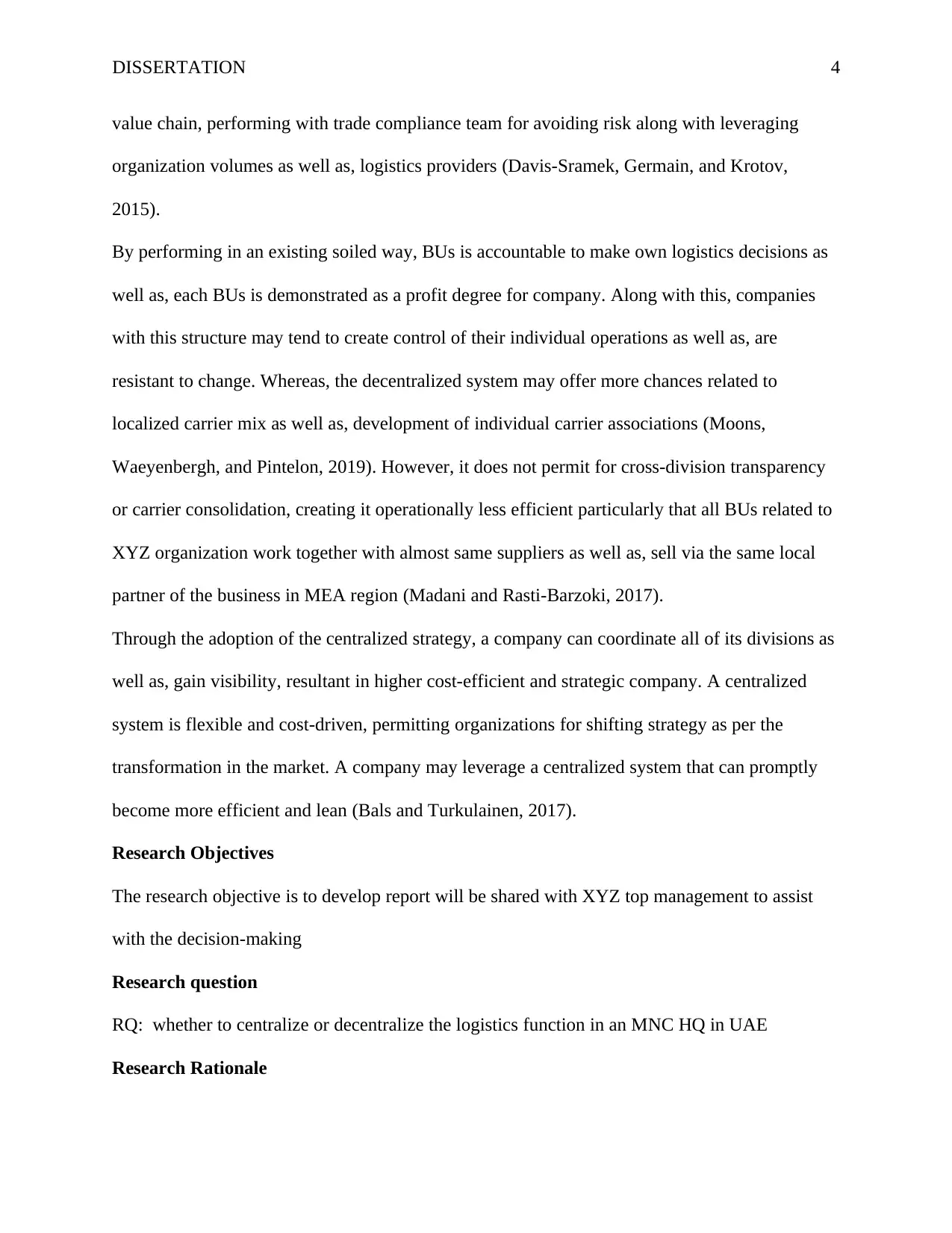
DISSERTATION 4
value chain, performing with trade compliance team for avoiding risk along with leveraging
organization volumes as well as, logistics providers (Davis-Sramek, Germain, and Krotov,
2015).
By performing in an existing soiled way, BUs is accountable to make own logistics decisions as
well as, each BUs is demonstrated as a profit degree for company. Along with this, companies
with this structure may tend to create control of their individual operations as well as, are
resistant to change. Whereas, the decentralized system may offer more chances related to
localized carrier mix as well as, development of individual carrier associations (Moons,
Waeyenbergh, and Pintelon, 2019). However, it does not permit for cross-division transparency
or carrier consolidation, creating it operationally less efficient particularly that all BUs related to
XYZ organization work together with almost same suppliers as well as, sell via the same local
partner of the business in MEA region (Madani and Rasti-Barzoki, 2017).
Through the adoption of the centralized strategy, a company can coordinate all of its divisions as
well as, gain visibility, resultant in higher cost-efficient and strategic company. A centralized
system is flexible and cost-driven, permitting organizations for shifting strategy as per the
transformation in the market. A company may leverage a centralized system that can promptly
become more efficient and lean (Bals and Turkulainen, 2017).
Research Objectives
The research objective is to develop report will be shared with XYZ top management to assist
with the decision-making
Research question
RQ: whether to centralize or decentralize the logistics function in an MNC HQ in UAE
Research Rationale
value chain, performing with trade compliance team for avoiding risk along with leveraging
organization volumes as well as, logistics providers (Davis-Sramek, Germain, and Krotov,
2015).
By performing in an existing soiled way, BUs is accountable to make own logistics decisions as
well as, each BUs is demonstrated as a profit degree for company. Along with this, companies
with this structure may tend to create control of their individual operations as well as, are
resistant to change. Whereas, the decentralized system may offer more chances related to
localized carrier mix as well as, development of individual carrier associations (Moons,
Waeyenbergh, and Pintelon, 2019). However, it does not permit for cross-division transparency
or carrier consolidation, creating it operationally less efficient particularly that all BUs related to
XYZ organization work together with almost same suppliers as well as, sell via the same local
partner of the business in MEA region (Madani and Rasti-Barzoki, 2017).
Through the adoption of the centralized strategy, a company can coordinate all of its divisions as
well as, gain visibility, resultant in higher cost-efficient and strategic company. A centralized
system is flexible and cost-driven, permitting organizations for shifting strategy as per the
transformation in the market. A company may leverage a centralized system that can promptly
become more efficient and lean (Bals and Turkulainen, 2017).
Research Objectives
The research objective is to develop report will be shared with XYZ top management to assist
with the decision-making
Research question
RQ: whether to centralize or decentralize the logistics function in an MNC HQ in UAE
Research Rationale
Paraphrase This Document
Need a fresh take? Get an instant paraphrase of this document with our AI Paraphraser
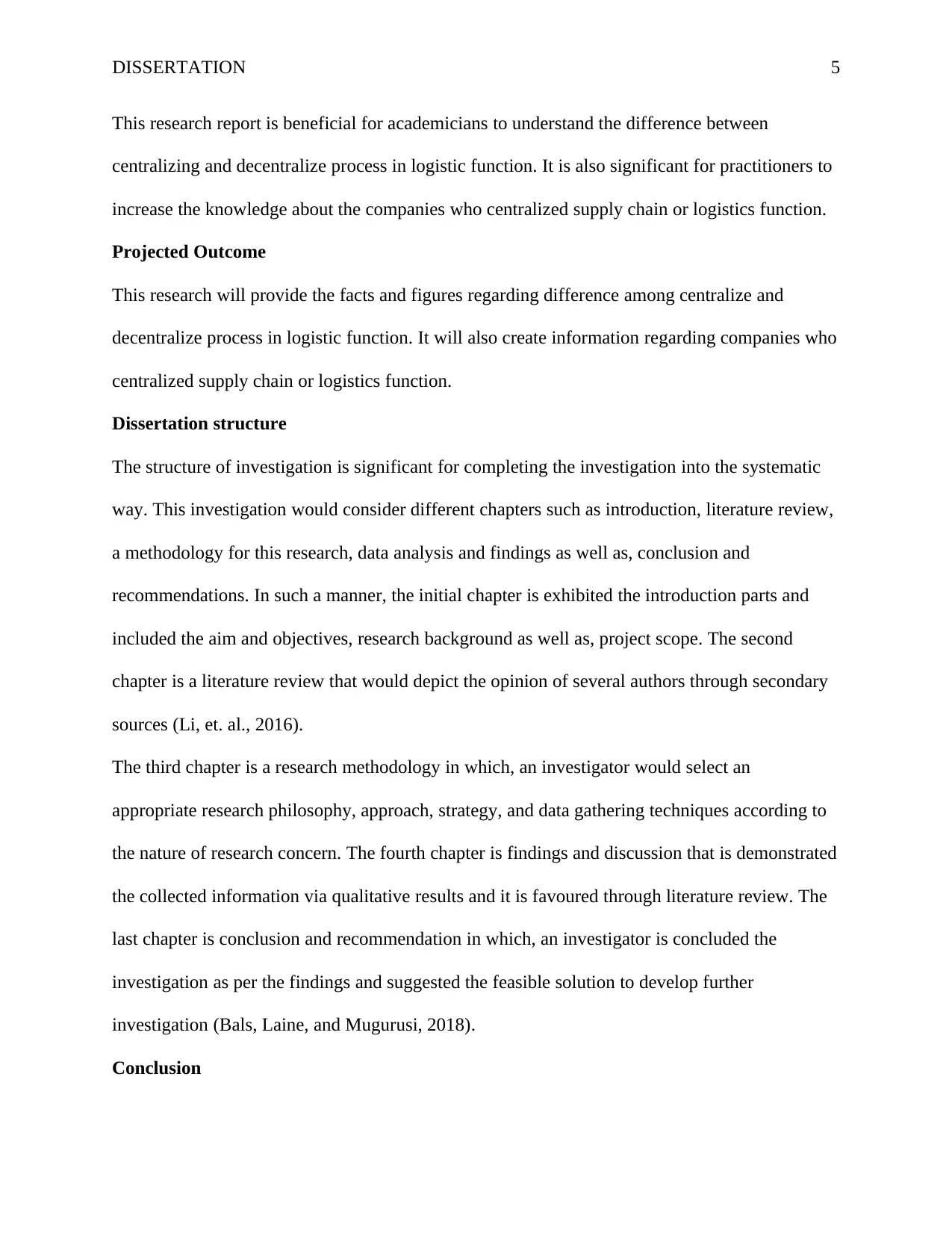
DISSERTATION 5
This research report is beneficial for academicians to understand the difference between
centralizing and decentralize process in logistic function. It is also significant for practitioners to
increase the knowledge about the companies who centralized supply chain or logistics function.
Projected Outcome
This research will provide the facts and figures regarding difference among centralize and
decentralize process in logistic function. It will also create information regarding companies who
centralized supply chain or logistics function.
Dissertation structure
The structure of investigation is significant for completing the investigation into the systematic
way. This investigation would consider different chapters such as introduction, literature review,
a methodology for this research, data analysis and findings as well as, conclusion and
recommendations. In such a manner, the initial chapter is exhibited the introduction parts and
included the aim and objectives, research background as well as, project scope. The second
chapter is a literature review that would depict the opinion of several authors through secondary
sources (Li, et. al., 2016).
The third chapter is a research methodology in which, an investigator would select an
appropriate research philosophy, approach, strategy, and data gathering techniques according to
the nature of research concern. The fourth chapter is findings and discussion that is demonstrated
the collected information via qualitative results and it is favoured through literature review. The
last chapter is conclusion and recommendation in which, an investigator is concluded the
investigation as per the findings and suggested the feasible solution to develop further
investigation (Bals, Laine, and Mugurusi, 2018).
Conclusion
This research report is beneficial for academicians to understand the difference between
centralizing and decentralize process in logistic function. It is also significant for practitioners to
increase the knowledge about the companies who centralized supply chain or logistics function.
Projected Outcome
This research will provide the facts and figures regarding difference among centralize and
decentralize process in logistic function. It will also create information regarding companies who
centralized supply chain or logistics function.
Dissertation structure
The structure of investigation is significant for completing the investigation into the systematic
way. This investigation would consider different chapters such as introduction, literature review,
a methodology for this research, data analysis and findings as well as, conclusion and
recommendations. In such a manner, the initial chapter is exhibited the introduction parts and
included the aim and objectives, research background as well as, project scope. The second
chapter is a literature review that would depict the opinion of several authors through secondary
sources (Li, et. al., 2016).
The third chapter is a research methodology in which, an investigator would select an
appropriate research philosophy, approach, strategy, and data gathering techniques according to
the nature of research concern. The fourth chapter is findings and discussion that is demonstrated
the collected information via qualitative results and it is favoured through literature review. The
last chapter is conclusion and recommendation in which, an investigator is concluded the
investigation as per the findings and suggested the feasible solution to develop further
investigation (Bals, Laine, and Mugurusi, 2018).
Conclusion
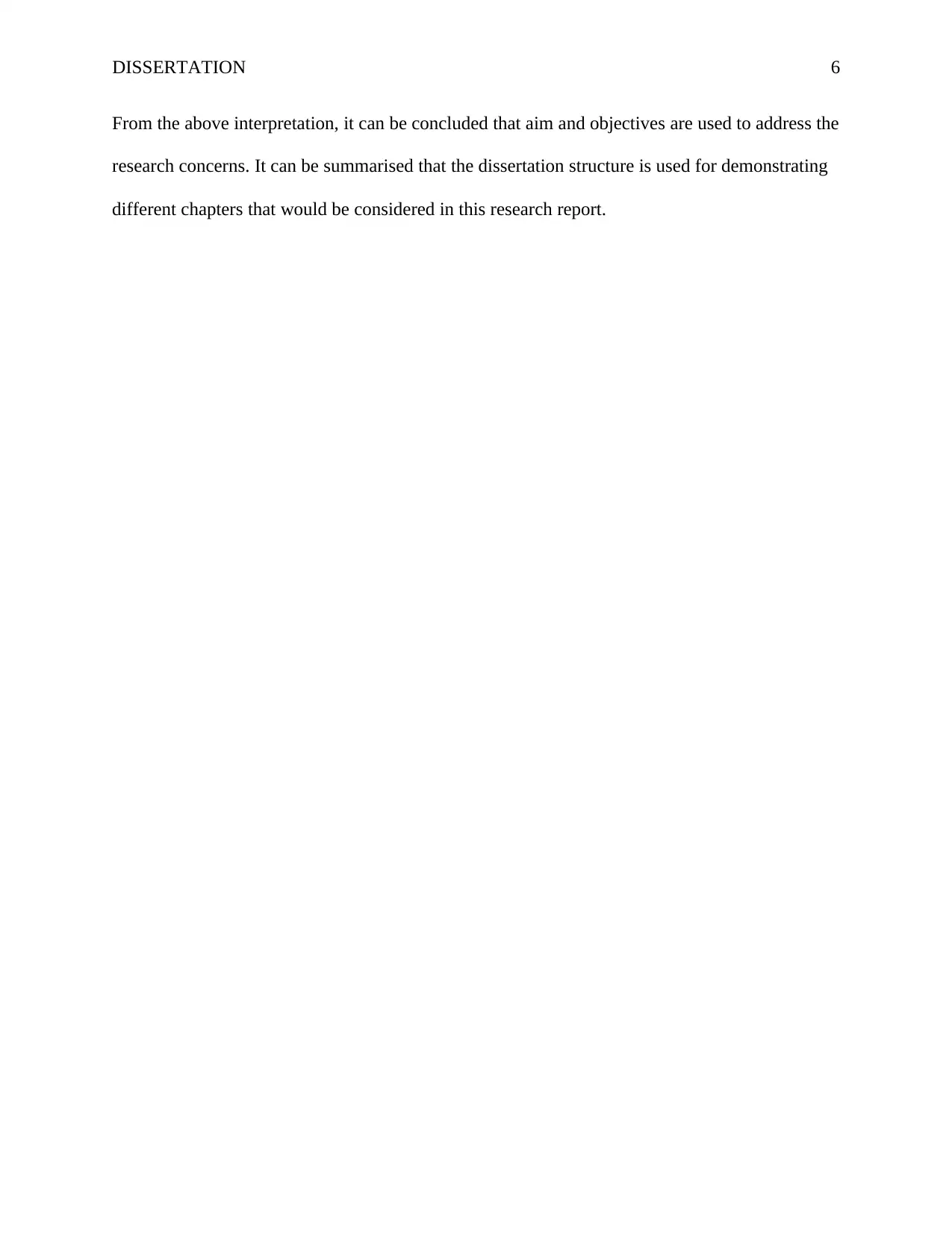
DISSERTATION 6
From the above interpretation, it can be concluded that aim and objectives are used to address the
research concerns. It can be summarised that the dissertation structure is used for demonstrating
different chapters that would be considered in this research report.
From the above interpretation, it can be concluded that aim and objectives are used to address the
research concerns. It can be summarised that the dissertation structure is used for demonstrating
different chapters that would be considered in this research report.
⊘ This is a preview!⊘
Do you want full access?
Subscribe today to unlock all pages.

Trusted by 1+ million students worldwide
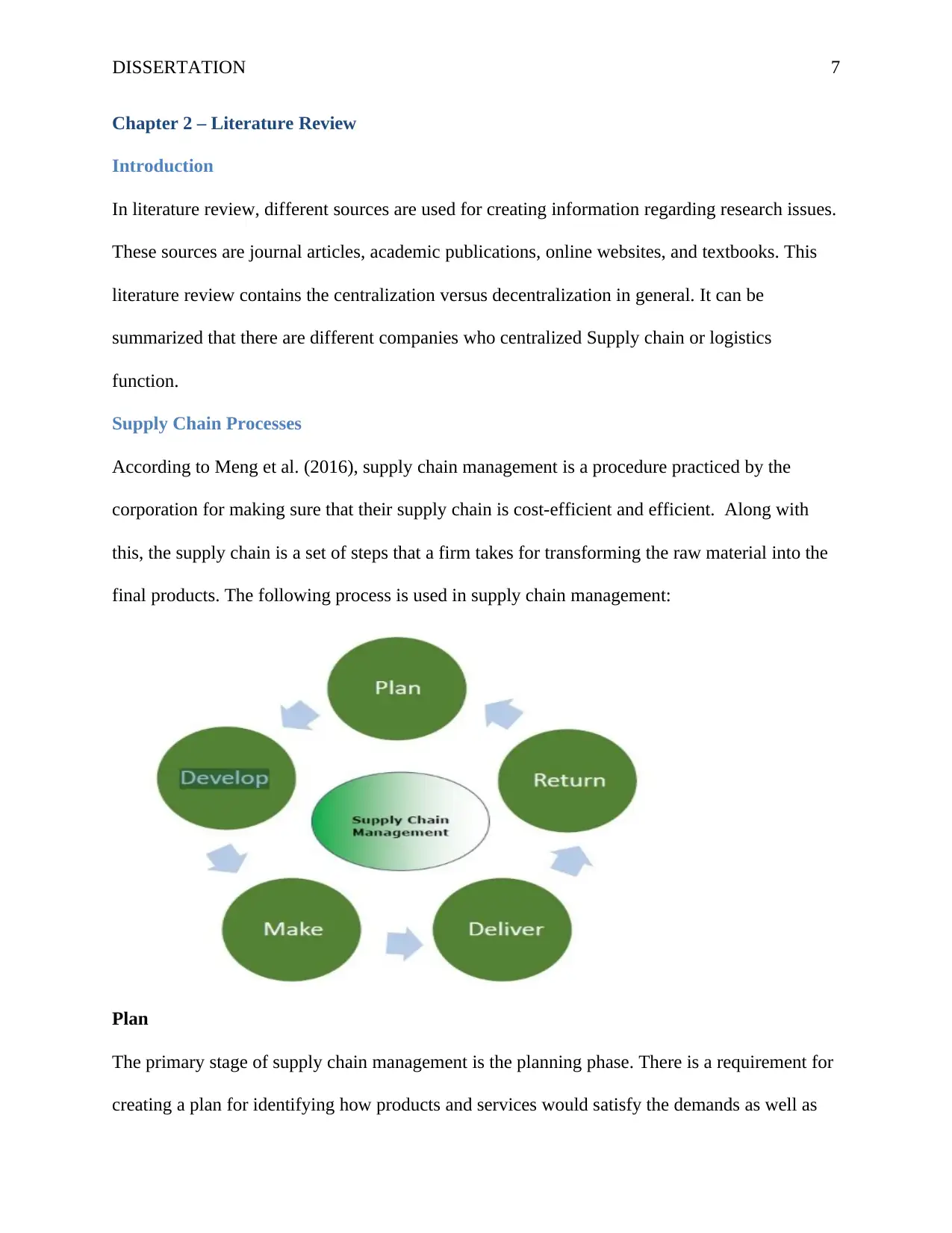
DISSERTATION 7
Chapter 2 – Literature Review
Introduction
In literature review, different sources are used for creating information regarding research issues.
These sources are journal articles, academic publications, online websites, and textbooks. This
literature review contains the centralization versus decentralization in general. It can be
summarized that there are different companies who centralized Supply chain or logistics
function.
Supply Chain Processes
According to Meng et al. (2016), supply chain management is a procedure practiced by the
corporation for making sure that their supply chain is cost-efficient and efficient. Along with
this, the supply chain is a set of steps that a firm takes for transforming the raw material into the
final products. The following process is used in supply chain management:
Plan
The primary stage of supply chain management is the planning phase. There is a requirement for
creating a plan for identifying how products and services would satisfy the demands as well as
Chapter 2 – Literature Review
Introduction
In literature review, different sources are used for creating information regarding research issues.
These sources are journal articles, academic publications, online websites, and textbooks. This
literature review contains the centralization versus decentralization in general. It can be
summarized that there are different companies who centralized Supply chain or logistics
function.
Supply Chain Processes
According to Meng et al. (2016), supply chain management is a procedure practiced by the
corporation for making sure that their supply chain is cost-efficient and efficient. Along with
this, the supply chain is a set of steps that a firm takes for transforming the raw material into the
final products. The following process is used in supply chain management:
Plan
The primary stage of supply chain management is the planning phase. There is a requirement for
creating a plan for identifying how products and services would satisfy the demands as well as
Paraphrase This Document
Need a fresh take? Get an instant paraphrase of this document with our AI Paraphraser
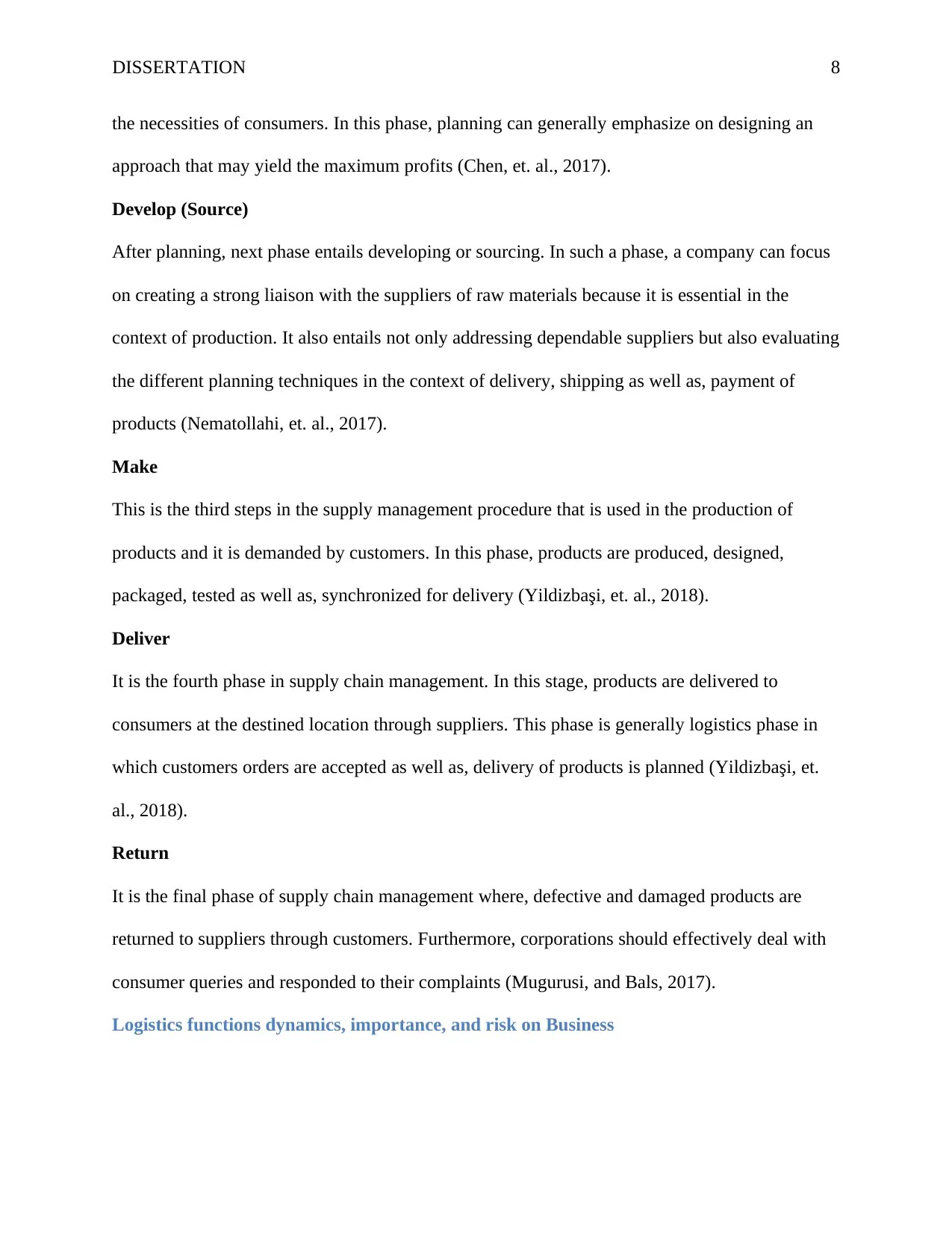
DISSERTATION 8
the necessities of consumers. In this phase, planning can generally emphasize on designing an
approach that may yield the maximum profits (Chen, et. al., 2017).
Develop (Source)
After planning, next phase entails developing or sourcing. In such a phase, a company can focus
on creating a strong liaison with the suppliers of raw materials because it is essential in the
context of production. It also entails not only addressing dependable suppliers but also evaluating
the different planning techniques in the context of delivery, shipping as well as, payment of
products (Nematollahi, et. al., 2017).
Make
This is the third steps in the supply management procedure that is used in the production of
products and it is demanded by customers. In this phase, products are produced, designed,
packaged, tested as well as, synchronized for delivery (Yildizbaşi, et. al., 2018).
Deliver
It is the fourth phase in supply chain management. In this stage, products are delivered to
consumers at the destined location through suppliers. This phase is generally logistics phase in
which customers orders are accepted as well as, delivery of products is planned (Yildizbaşi, et.
al., 2018).
Return
It is the final phase of supply chain management where, defective and damaged products are
returned to suppliers through customers. Furthermore, corporations should effectively deal with
consumer queries and responded to their complaints (Mugurusi, and Bals, 2017).
Logistics functions dynamics, importance, and risk on Business
the necessities of consumers. In this phase, planning can generally emphasize on designing an
approach that may yield the maximum profits (Chen, et. al., 2017).
Develop (Source)
After planning, next phase entails developing or sourcing. In such a phase, a company can focus
on creating a strong liaison with the suppliers of raw materials because it is essential in the
context of production. It also entails not only addressing dependable suppliers but also evaluating
the different planning techniques in the context of delivery, shipping as well as, payment of
products (Nematollahi, et. al., 2017).
Make
This is the third steps in the supply management procedure that is used in the production of
products and it is demanded by customers. In this phase, products are produced, designed,
packaged, tested as well as, synchronized for delivery (Yildizbaşi, et. al., 2018).
Deliver
It is the fourth phase in supply chain management. In this stage, products are delivered to
consumers at the destined location through suppliers. This phase is generally logistics phase in
which customers orders are accepted as well as, delivery of products is planned (Yildizbaşi, et.
al., 2018).
Return
It is the final phase of supply chain management where, defective and damaged products are
returned to suppliers through customers. Furthermore, corporations should effectively deal with
consumer queries and responded to their complaints (Mugurusi, and Bals, 2017).
Logistics functions dynamics, importance, and risk on Business
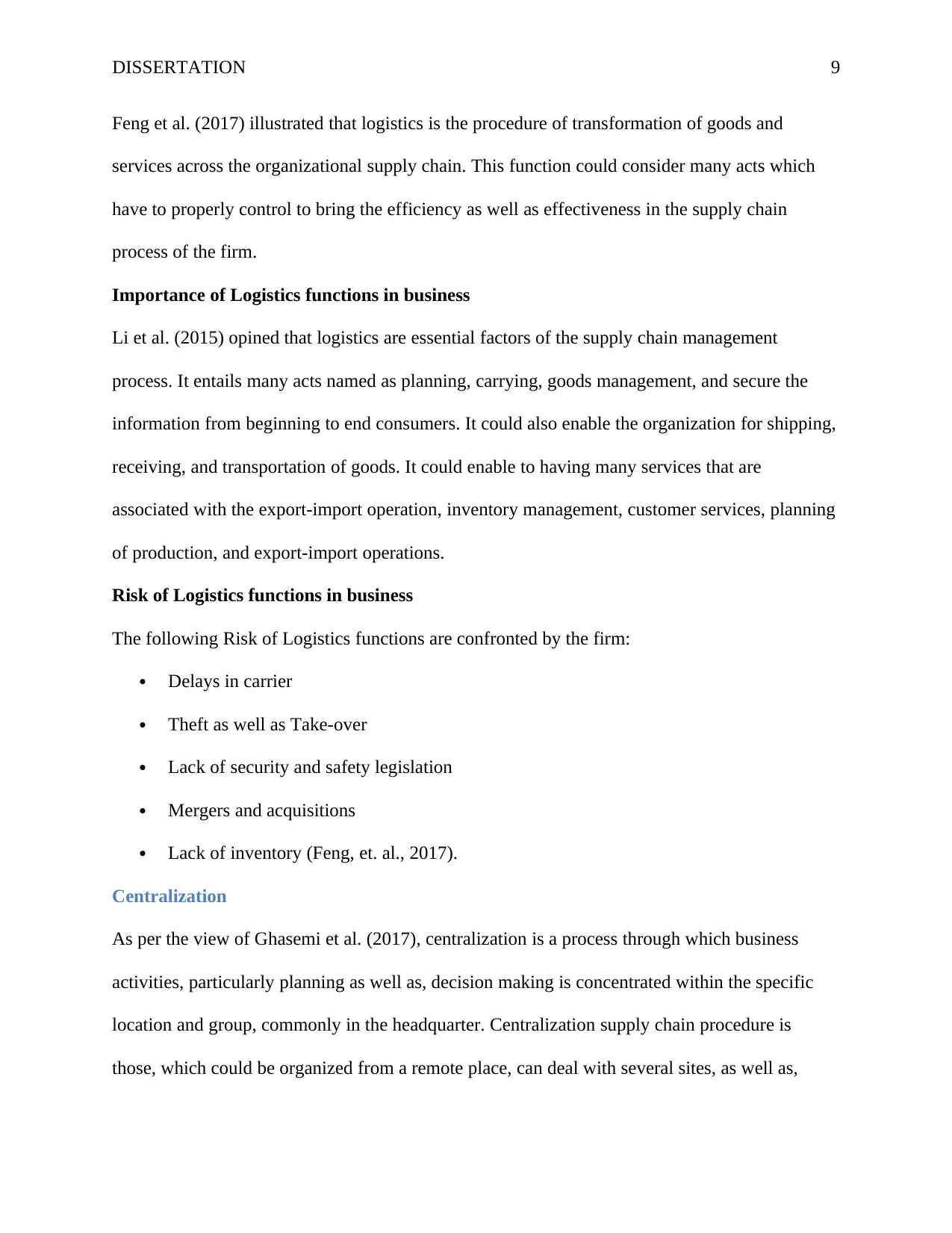
DISSERTATION 9
Feng et al. (2017) illustrated that logistics is the procedure of transformation of goods and
services across the organizational supply chain. This function could consider many acts which
have to properly control to bring the efficiency as well as effectiveness in the supply chain
process of the firm.
Importance of Logistics functions in business
Li et al. (2015) opined that logistics are essential factors of the supply chain management
process. It entails many acts named as planning, carrying, goods management, and secure the
information from beginning to end consumers. It could also enable the organization for shipping,
receiving, and transportation of goods. It could enable to having many services that are
associated with the export-import operation, inventory management, customer services, planning
of production, and export-import operations.
Risk of Logistics functions in business
The following Risk of Logistics functions are confronted by the firm:
Delays in carrier
Theft as well as Take-over
Lack of security and safety legislation
Mergers and acquisitions
Lack of inventory (Feng, et. al., 2017).
Centralization
As per the view of Ghasemi et al. (2017), centralization is a process through which business
activities, particularly planning as well as, decision making is concentrated within the specific
location and group, commonly in the headquarter. Centralization supply chain procedure is
those, which could be organized from a remote place, can deal with several sites, as well as,
Feng et al. (2017) illustrated that logistics is the procedure of transformation of goods and
services across the organizational supply chain. This function could consider many acts which
have to properly control to bring the efficiency as well as effectiveness in the supply chain
process of the firm.
Importance of Logistics functions in business
Li et al. (2015) opined that logistics are essential factors of the supply chain management
process. It entails many acts named as planning, carrying, goods management, and secure the
information from beginning to end consumers. It could also enable the organization for shipping,
receiving, and transportation of goods. It could enable to having many services that are
associated with the export-import operation, inventory management, customer services, planning
of production, and export-import operations.
Risk of Logistics functions in business
The following Risk of Logistics functions are confronted by the firm:
Delays in carrier
Theft as well as Take-over
Lack of security and safety legislation
Mergers and acquisitions
Lack of inventory (Feng, et. al., 2017).
Centralization
As per the view of Ghasemi et al. (2017), centralization is a process through which business
activities, particularly planning as well as, decision making is concentrated within the specific
location and group, commonly in the headquarter. Centralization supply chain procedure is
those, which could be organized from a remote place, can deal with several sites, as well as,
⊘ This is a preview!⊘
Do you want full access?
Subscribe today to unlock all pages.

Trusted by 1+ million students worldwide
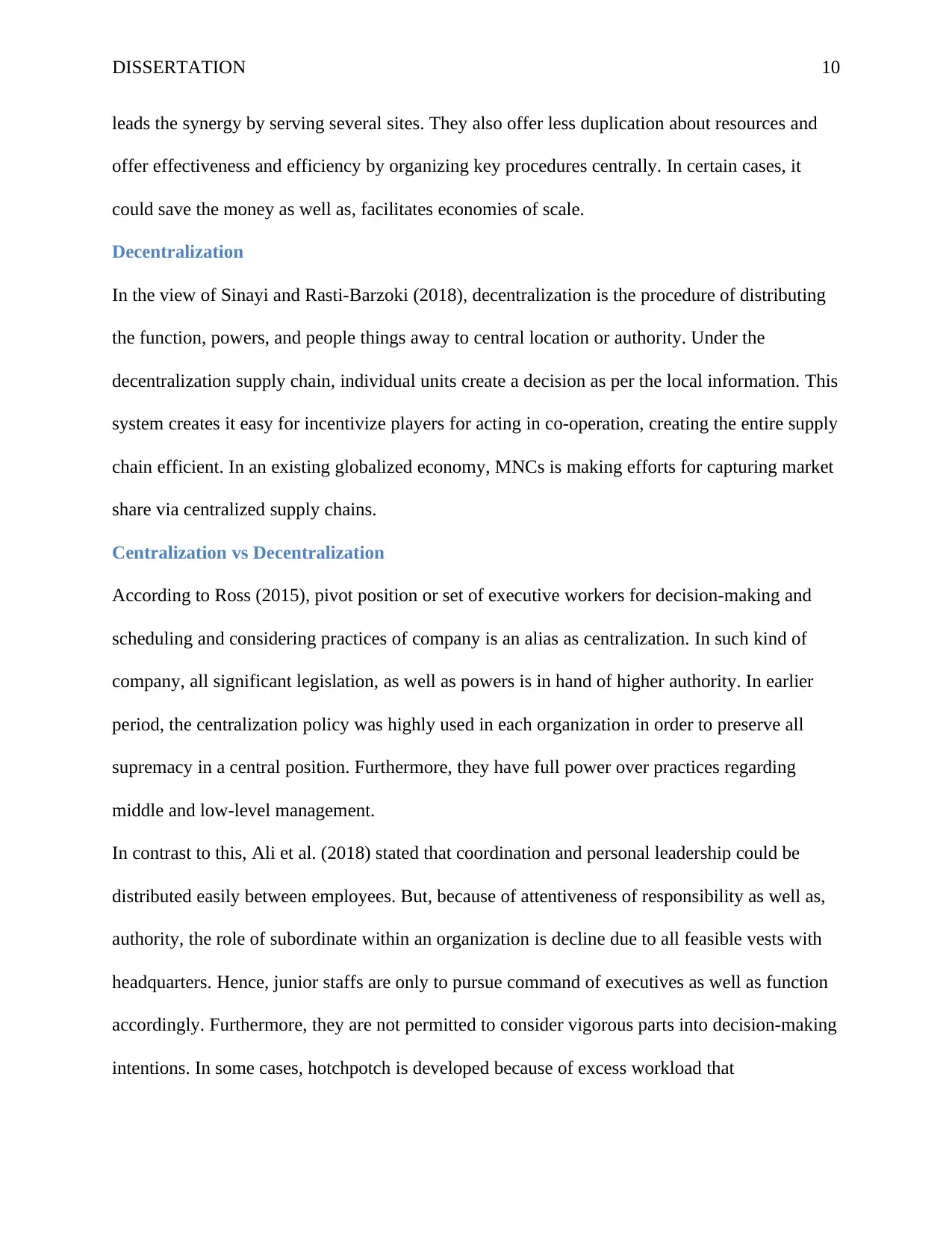
DISSERTATION 10
leads the synergy by serving several sites. They also offer less duplication about resources and
offer effectiveness and efficiency by organizing key procedures centrally. In certain cases, it
could save the money as well as, facilitates economies of scale.
Decentralization
In the view of Sinayi and Rasti-Barzoki (2018), decentralization is the procedure of distributing
the function, powers, and people things away to central location or authority. Under the
decentralization supply chain, individual units create a decision as per the local information. This
system creates it easy for incentivize players for acting in co-operation, creating the entire supply
chain efficient. In an existing globalized economy, MNCs is making efforts for capturing market
share via centralized supply chains.
Centralization vs Decentralization
According to Ross (2015), pivot position or set of executive workers for decision-making and
scheduling and considering practices of company is an alias as centralization. In such kind of
company, all significant legislation, as well as powers is in hand of higher authority. In earlier
period, the centralization policy was highly used in each organization in order to preserve all
supremacy in a central position. Furthermore, they have full power over practices regarding
middle and low-level management.
In contrast to this, Ali et al. (2018) stated that coordination and personal leadership could be
distributed easily between employees. But, because of attentiveness of responsibility as well as,
authority, the role of subordinate within an organization is decline due to all feasible vests with
headquarters. Hence, junior staffs are only to pursue command of executives as well as function
accordingly. Furthermore, they are not permitted to consider vigorous parts into decision-making
intentions. In some cases, hotchpotch is developed because of excess workload that
leads the synergy by serving several sites. They also offer less duplication about resources and
offer effectiveness and efficiency by organizing key procedures centrally. In certain cases, it
could save the money as well as, facilitates economies of scale.
Decentralization
In the view of Sinayi and Rasti-Barzoki (2018), decentralization is the procedure of distributing
the function, powers, and people things away to central location or authority. Under the
decentralization supply chain, individual units create a decision as per the local information. This
system creates it easy for incentivize players for acting in co-operation, creating the entire supply
chain efficient. In an existing globalized economy, MNCs is making efforts for capturing market
share via centralized supply chains.
Centralization vs Decentralization
According to Ross (2015), pivot position or set of executive workers for decision-making and
scheduling and considering practices of company is an alias as centralization. In such kind of
company, all significant legislation, as well as powers is in hand of higher authority. In earlier
period, the centralization policy was highly used in each organization in order to preserve all
supremacy in a central position. Furthermore, they have full power over practices regarding
middle and low-level management.
In contrast to this, Ali et al. (2018) stated that coordination and personal leadership could be
distributed easily between employees. But, because of attentiveness of responsibility as well as,
authority, the role of subordinate within an organization is decline due to all feasible vests with
headquarters. Hence, junior staffs are only to pursue command of executives as well as function
accordingly. Furthermore, they are not permitted to consider vigorous parts into decision-making
intentions. In some cases, hotchpotch is developed because of excess workload that
Paraphrase This Document
Need a fresh take? Get an instant paraphrase of this document with our AI Paraphraser
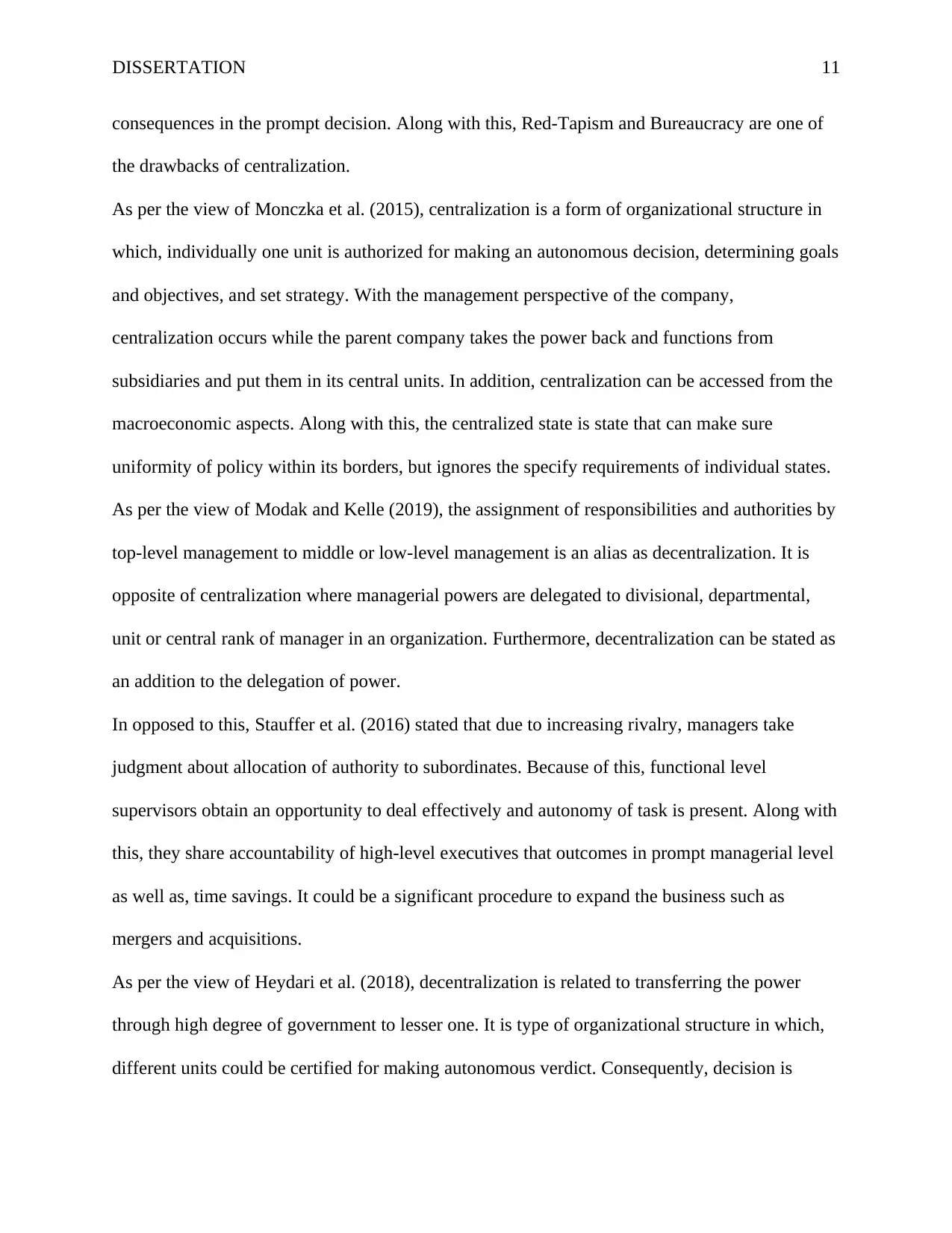
DISSERTATION 11
consequences in the prompt decision. Along with this, Red-Tapism and Bureaucracy are one of
the drawbacks of centralization.
As per the view of Monczka et al. (2015), centralization is a form of organizational structure in
which, individually one unit is authorized for making an autonomous decision, determining goals
and objectives, and set strategy. With the management perspective of the company,
centralization occurs while the parent company takes the power back and functions from
subsidiaries and put them in its central units. In addition, centralization can be accessed from the
macroeconomic aspects. Along with this, the centralized state is state that can make sure
uniformity of policy within its borders, but ignores the specify requirements of individual states.
As per the view of Modak and Kelle (2019), the assignment of responsibilities and authorities by
top-level management to middle or low-level management is an alias as decentralization. It is
opposite of centralization where managerial powers are delegated to divisional, departmental,
unit or central rank of manager in an organization. Furthermore, decentralization can be stated as
an addition to the delegation of power.
In opposed to this, Stauffer et al. (2016) stated that due to increasing rivalry, managers take
judgment about allocation of authority to subordinates. Because of this, functional level
supervisors obtain an opportunity to deal effectively and autonomy of task is present. Along with
this, they share accountability of high-level executives that outcomes in prompt managerial level
as well as, time savings. It could be a significant procedure to expand the business such as
mergers and acquisitions.
As per the view of Heydari et al. (2018), decentralization is related to transferring the power
through high degree of government to lesser one. It is type of organizational structure in which,
different units could be certified for making autonomous verdict. Consequently, decision is
consequences in the prompt decision. Along with this, Red-Tapism and Bureaucracy are one of
the drawbacks of centralization.
As per the view of Monczka et al. (2015), centralization is a form of organizational structure in
which, individually one unit is authorized for making an autonomous decision, determining goals
and objectives, and set strategy. With the management perspective of the company,
centralization occurs while the parent company takes the power back and functions from
subsidiaries and put them in its central units. In addition, centralization can be accessed from the
macroeconomic aspects. Along with this, the centralized state is state that can make sure
uniformity of policy within its borders, but ignores the specify requirements of individual states.
As per the view of Modak and Kelle (2019), the assignment of responsibilities and authorities by
top-level management to middle or low-level management is an alias as decentralization. It is
opposite of centralization where managerial powers are delegated to divisional, departmental,
unit or central rank of manager in an organization. Furthermore, decentralization can be stated as
an addition to the delegation of power.
In opposed to this, Stauffer et al. (2016) stated that due to increasing rivalry, managers take
judgment about allocation of authority to subordinates. Because of this, functional level
supervisors obtain an opportunity to deal effectively and autonomy of task is present. Along with
this, they share accountability of high-level executives that outcomes in prompt managerial level
as well as, time savings. It could be a significant procedure to expand the business such as
mergers and acquisitions.
As per the view of Heydari et al. (2018), decentralization is related to transferring the power
through high degree of government to lesser one. It is type of organizational structure in which,
different units could be certified for making autonomous verdict. Consequently, decision is
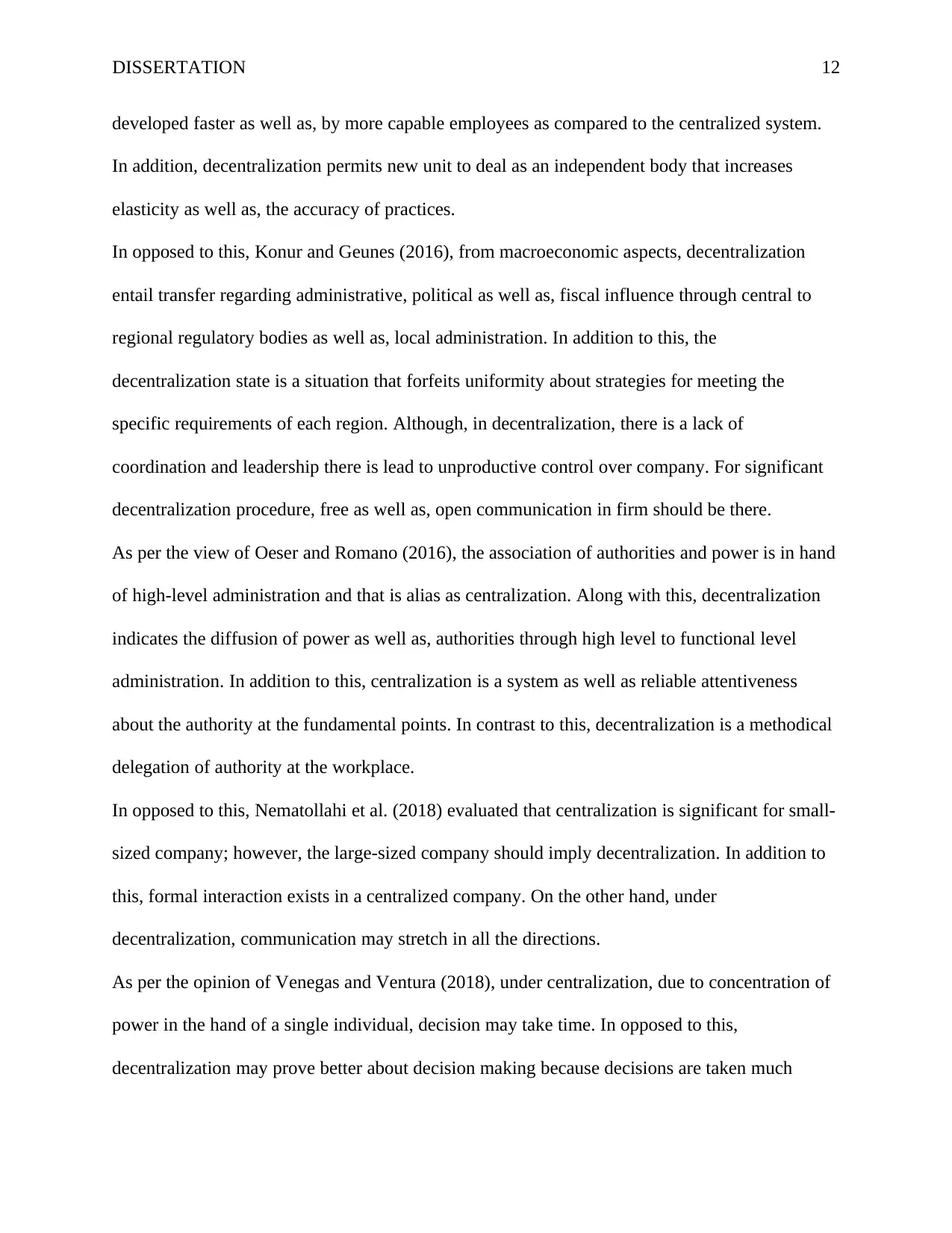
DISSERTATION 12
developed faster as well as, by more capable employees as compared to the centralized system.
In addition, decentralization permits new unit to deal as an independent body that increases
elasticity as well as, the accuracy of practices.
In opposed to this, Konur and Geunes (2016), from macroeconomic aspects, decentralization
entail transfer regarding administrative, political as well as, fiscal influence through central to
regional regulatory bodies as well as, local administration. In addition to this, the
decentralization state is a situation that forfeits uniformity about strategies for meeting the
specific requirements of each region. Although, in decentralization, there is a lack of
coordination and leadership there is lead to unproductive control over company. For significant
decentralization procedure, free as well as, open communication in firm should be there.
As per the view of Oeser and Romano (2016), the association of authorities and power is in hand
of high-level administration and that is alias as centralization. Along with this, decentralization
indicates the diffusion of power as well as, authorities through high level to functional level
administration. In addition to this, centralization is a system as well as reliable attentiveness
about the authority at the fundamental points. In contrast to this, decentralization is a methodical
delegation of authority at the workplace.
In opposed to this, Nematollahi et al. (2018) evaluated that centralization is significant for small-
sized company; however, the large-sized company should imply decentralization. In addition to
this, formal interaction exists in a centralized company. On the other hand, under
decentralization, communication may stretch in all the directions.
As per the opinion of Venegas and Ventura (2018), under centralization, due to concentration of
power in the hand of a single individual, decision may take time. In opposed to this,
decentralization may prove better about decision making because decisions are taken much
developed faster as well as, by more capable employees as compared to the centralized system.
In addition, decentralization permits new unit to deal as an independent body that increases
elasticity as well as, the accuracy of practices.
In opposed to this, Konur and Geunes (2016), from macroeconomic aspects, decentralization
entail transfer regarding administrative, political as well as, fiscal influence through central to
regional regulatory bodies as well as, local administration. In addition to this, the
decentralization state is a situation that forfeits uniformity about strategies for meeting the
specific requirements of each region. Although, in decentralization, there is a lack of
coordination and leadership there is lead to unproductive control over company. For significant
decentralization procedure, free as well as, open communication in firm should be there.
As per the view of Oeser and Romano (2016), the association of authorities and power is in hand
of high-level administration and that is alias as centralization. Along with this, decentralization
indicates the diffusion of power as well as, authorities through high level to functional level
administration. In addition to this, centralization is a system as well as reliable attentiveness
about the authority at the fundamental points. In contrast to this, decentralization is a methodical
delegation of authority at the workplace.
In opposed to this, Nematollahi et al. (2018) evaluated that centralization is significant for small-
sized company; however, the large-sized company should imply decentralization. In addition to
this, formal interaction exists in a centralized company. On the other hand, under
decentralization, communication may stretch in all the directions.
As per the opinion of Venegas and Ventura (2018), under centralization, due to concentration of
power in the hand of a single individual, decision may take time. In opposed to this,
decentralization may prove better about decision making because decisions are taken much
⊘ This is a preview!⊘
Do you want full access?
Subscribe today to unlock all pages.

Trusted by 1+ million students worldwide
1 out of 58
Related Documents
Your All-in-One AI-Powered Toolkit for Academic Success.
+13062052269
info@desklib.com
Available 24*7 on WhatsApp / Email
![[object Object]](/_next/static/media/star-bottom.7253800d.svg)
Unlock your academic potential
Copyright © 2020–2025 A2Z Services. All Rights Reserved. Developed and managed by ZUCOL.



